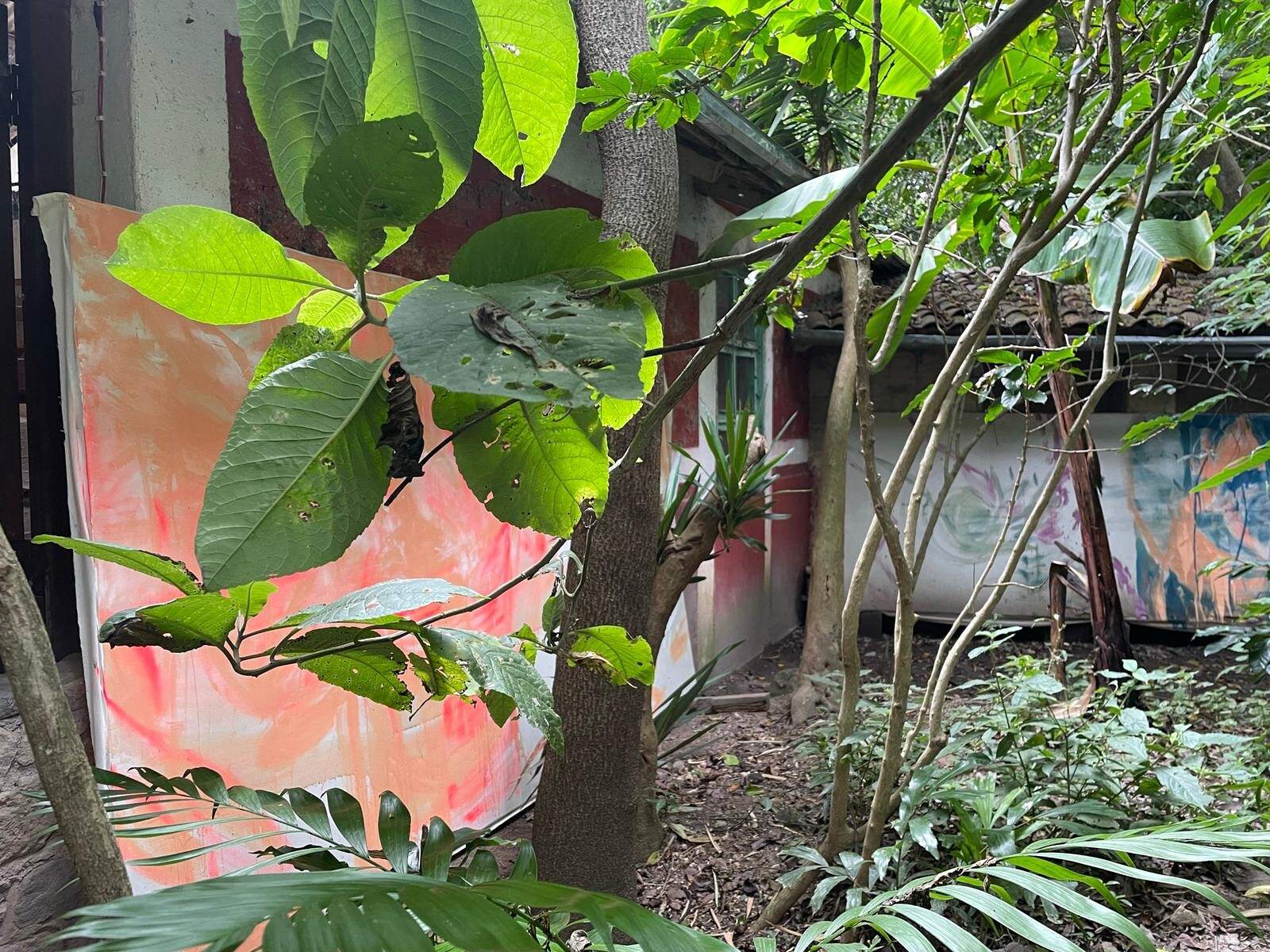Worm in a Water Glass
January 29–July 3, 2022
Markt 1
4331 LJ Middelburg
The Netherlands
Hours: Wednesday–Friday 1–5pm,
Saturday–Sunday 11am–5pm
T +31 118 652 200
office@vleeshal.nl
From: Vivian Suter
Date: Wed, 29 April 2020, at 23:51
Subject: Rain started
To: Roos Gortzak
Dear Roos, I hope you are well.
I want to thank you for the invitation.
Please tell me if you have any thoughts.
Love from Panajachel, Vivian
On Fri, Roos Gortzak wrote:
Dear Vivian,
It’s nice to read your words! I’d be curious to hear your thoughts. Do you have works in mind when you see Vleeshal’s space that you’d like to bring together there? I’m very open to all your suggestions. I remember coming to your Basel studio in 2011 and we picked many works, brought them all over and decided in the space what we were showing. Perhaps this is how you’d like to work for Vleeshal too?
On another note, I’ve just finished Vivian Gornick’s book ‘The Odd Woman and the City’ and I really liked it. Perhaps you know it? I found this quote in an interview with her in The New Yorker that reminded me of you:
“I asked Gornick how she knew that literature was something worthy of study. She looked at me as if I had asked how she knew that clean water was good to drink. I felt ashamed. Like her mother, I was thinking in terms of the market, and she in terms of the soul.”
Much love,
Roos
On Thu, Vivian Suter wrote:
Dear Roos, yes I feel like an odd woman and clean water is not always as you would like it from a spring. We have to use bottled water. Once, really only once since Covid, I had one visitor for lunch. And then, the invited woman saw a worm in my carafe with water that I was about to pour into our glasses. Since then I haven’t had any visitors anymore, I just couldn’t do it. If you dare, you are welcome. All my best, Vivian
Worm in a Water Glass
We dared, we went and selected 89 paintings for Vivian Suter’s show at Vleeshal, which we dedicated to the worm in the water glass. It is impossible to consider the paintings of Vivian Suter (Buenos Aires, 1949) without discussing where and how she lives and works. Since 1983, Suter has resided on the grounds of a former coffee plantation just outside Panajachel, Guatemala. This small village is situated along the shores of the breath-taking and incredibly deep Lake Atitlán, which is enclosed by volcanoes. Here, in her own remote micro-cosmos just outside the village, the incredibly productive Suter paints whenever she can, in a life guided by recurring rituals. Each day, for example, she decides where to paint: down by the mango tree, which is covered by the shade of tall tropical greenery, or in and around her studio further up the hill. From up there, you could once admire an incredible vista of Atitlán and the surrounding mountain range. In the present, you can only see a dense labyrinth of branches and foliage from trees that the artist once planted on the slope of the mountain. Over the years, Suter observed how the view gradually changed, letting it happen, and enjoying every stage of the process equally. This approach also characterizes Suter’s work. The natural environment, her direct surroundings, have become part of the painterly process. Tropical rains wash away new brushstrokes, leaves and mud stick to drying paint, and her three beloved dogs leave their footprints on the canvases, whether she likes it or not. For Suter, life and making art are not only intertwined, but also possess a certain inevitability.
There is a risk of exotisizing and romanticizing Vivian Suter’s life-work in Guatemala. A repeated version of this story goes as follows: by leaving the vibrant Basel art scene in the 1980s, Suter chose a reclusive life in Panajachel, turning her back on the rest of the world to focus solely on her art. In many ways, however, Suter is in fact very much connected with the world. She exists at an intersection where countless axes of global displacement and struggle come together—be it her family history shaped by migration, recurring natural disasters in the tropics, or histories of colonialism and civil war that determine her conditions in the present. But above all, Vivian Suter is in a constant and reciprocal relationship with her surroundings, being as near to them as possible, by attempting to put them into her paintings, as they exist in that moment. It is therefore not surprising that the artist has no interest in linear chronology. Each time she installs her paintings together in a space, collectively, they establish a new work of art, formulating other relationships, meanings and perspectives. We look forward to being at Vleeshal with Vivian, hanging her 89 paintings to make ‘Worm in a Water Glass’. And we invite you to lose track in this cosmos. As Nabila Abdel Nabi has once written: “Entering the universe of Vivian Suter’s paintings shifts one’s sense of being in time.”
Exhibition dates are subject to Dutch COVID-19 measures. Visit our website for up-to-date information.



